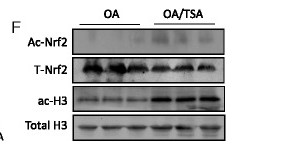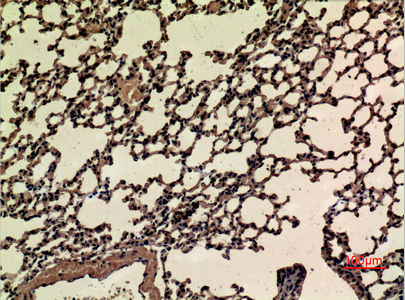Nrf2 (Acetyl Lys599) Polyclonal Antibody
- Catalog No.:YK0063
- Applications:WB;IHC;IF;ELISA
- Reactivity:Human;Mouse;Rat
- Target:
- Nrf2
- Fields:
- >>Protein processing in endoplasmic reticulum;>>Parkinson disease;>>Pathways in cancer;>>Chemical carcinogenesis - reactive oxygen species;>>Hepatocellular carcinoma;>>Lipid and atherosclerosis;>>Fluid shear stress and atherosclerosis
- Gene Name:
- NFE2L2
- Protein Name:
- Nuclear factor erythroid 2-related factor 2
- Human Gene Id:
- 4780
- Human Swiss Prot No:
- Q16236
- Mouse Gene Id:
- 18024
- Mouse Swiss Prot No:
- Q60795
- Rat Gene Id:
- 83619
- Rat Swiss Prot No:
- O54968
- Immunogen:
- Synthesized acetyl-peptide derived from the C-terminal region of human Nrf2 around the acetylation site of K599.
- Specificity:
- Acetyl-Nrf2 (K599) Polyclonal Antibody detects endogenous levels of Nrf2 protein only when acetylation at K599.
- Formulation:
- Liquid in PBS containing 50% glycerol, 0.5% BSA and 0.02% sodium azide.
- Source:
- Polyclonal, Rabbit,IgG
- Dilution:
- WB 1:500 - 1:2000. IHC: 1:100-300 ELISA: 1:10000.. IF 1:50-200
- Purification:
- The antibody was affinity-purified from rabbit antiserum by affinity-chromatography using epitope-specific immunogen.
- Concentration:
- 1 mg/ml
- Storage Stability:
- -15°C to -25°C/1 year(Do not lower than -25°C)
- Other Name:
- NFE2L2;NRF2;Nuclear factor erythroid 2-related factor 2;NF-E2-related factor 2;NFE2-related factor 2;HEBP1;Nuclear factor, erythroid derived 2, like 2
- Observed Band(KD):
- 75-100kD
- Background:
- This gene encodes a transcription factor which is a member of a small family of basic leucine zipper (bZIP) proteins. The encoded transcription factor regulates genes which contain antioxidant response elements (ARE) in their promoters; many of these genes encode proteins involved in response to injury and inflammation which includes the production of free radicals. Multiple transcript variants encoding different isoforms have been characterized for this gene. [provided by RefSeq, Sep 2015],
- Function:
- domain:Acidic activation domain in the N-terminus, and DNA binding domain in the C-terminus.,function:Transcription activator that binds to antioxidant response (ARE) elements in the promoter regions of target genes. Important for the coordinated up-regulation of genes in response to oxidative stress. May be involved in the transcriptional activation of genes of the beta-globin cluster by mediating enhancer activity of hypersensitive site 2 of the beta-globin locus control region.,PTM:Phosphorylation of Ser-40 by PKC in response to oxidative stress dissociates NFE2L2 from its cytoplasmic inhibitor KEAP1, promoting its translocation into the nucleus.,similarity:Belongs to the bZIP family.,similarity:Belongs to the bZIP family. CNC subfamily.,similarity:Contains 1 bZIP domain.,subcellular location:Cytosolic under unstressed conditions, translocates into the nucleus upon induction by electr
- Subcellular Location:
- Cytoplasm, cytosol . Nucleus . Cytosolic under unstressed conditions: ubiquitinated and degraded by the BCR(KEAP1) E3 ubiquitin ligase complex (PubMed:15601839, PubMed:21196497). Translocates into the nucleus upon induction by electrophilic agents that inactivate the BCR(KEAP1) E3 ubiquitin ligase complex (PubMed:21196497). .
- Expression:
- Widely expressed. Highest expression in adult muscle, kidney, lung, liver and in fetal muscle.
The link between deacetylation and hepatotoxicity induced by exposure to hexavalent chromium. Journal of Advanced Research J Adv Res. 2021 Apr;: WB Rat Liver
Histone deacetylase inhibition activates Nrf2 and protects against osteoarthritis. ARTHRITIS RESEARCH & THERAPY Arthritis Res Ther. 2015 Dec;17(1):1-11 WB Human HEK293 cell
Nuclear Factor (Erythroid-Derived 2)-Like 2 (Nrf2) Contributes to the Neuroprotective Effects of Histone Deacetylase Inhibitors In Retinal Ischemia–Reperfusion Injury. NEUROSCIENCE 2019 Aug 20 WB Mouse retina
Nassar, Noha N., et al. "Saxagliptin: a novel antiparkinsonian approach." Neuropharmacology 89 (2015): 308-317.
Astilbin targeted Sirt1 to inhibit acetylation of Nrf2 to alleviate grass carp hepatocyte apoptosis caused by PCB126-induced mitochondrial kinetic and metabolism dysfunctions. FISH & SHELLFISH IMMUNOLOGY Shu Li WB Fish 1:500,1:2000 L8824 cell
- June 19-2018
- WESTERN IMMUNOBLOTTING PROTOCOL
- June 19-2018
- IMMUNOHISTOCHEMISTRY-PARAFFIN PROTOCOL
- June 19-2018
- IMMUNOFLUORESCENCE PROTOCOL
- September 08-2020
- FLOW-CYTOMEYRT-PROTOCOL
- May 20-2022
- Cell-Based ELISA│解您多样本WB检测之困扰
- July 13-2018
- CELL-BASED-ELISA-PROTOCOL-FOR-ACETYL-PROTEIN
- July 13-2018
- CELL-BASED-ELISA-PROTOCOL-FOR-PHOSPHO-PROTEIN
- July 13-2018
- Antibody-FAQs
- Products Images

- Cai, Dawei, et al. "Histone deacetylase inhibition activates Nrf2 and protects against osteoarthritis." Arthritis research & therapy 17.1 (2015): 269.

- Western Blot analysis of A549 cells using Acetyl-Nrf2 (K599) Polyclonal Antibody. Antibody was diluted at 1:1000. Secondary antibody(catalog#:RS0002) was diluted at 1:20000
.jpg)
- Immunohistochemical analysis of paraffin-embedded rat-lung, antibody was diluted at 1:100

- Immunohistochemical analysis of paraffin-embedded mouse-lung, antibody was diluted at 1:100



